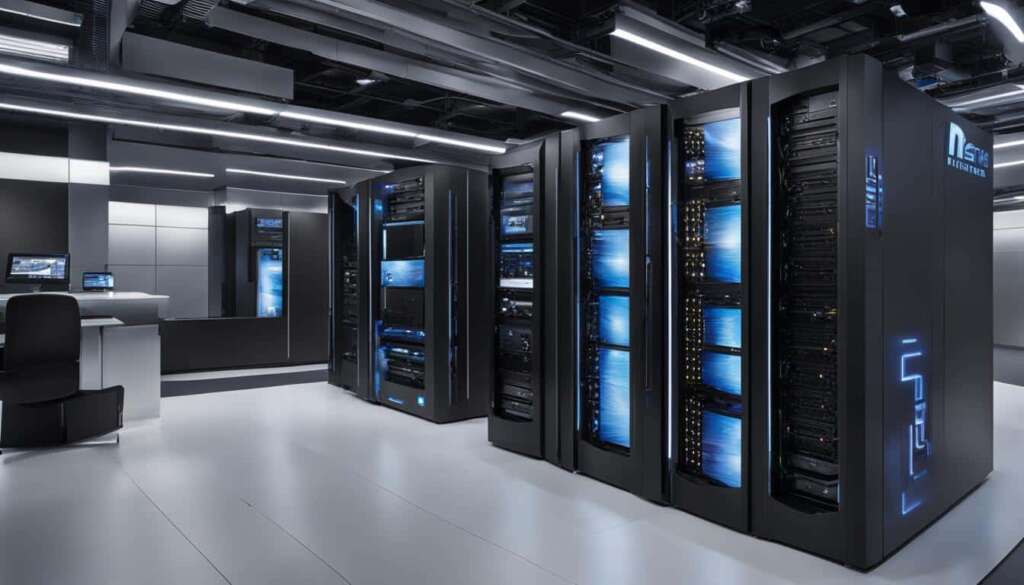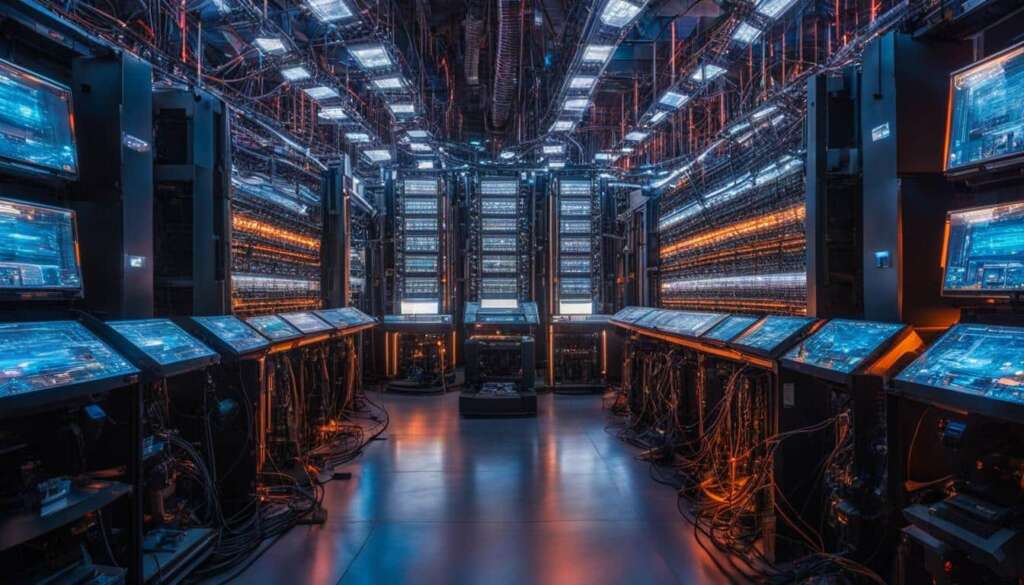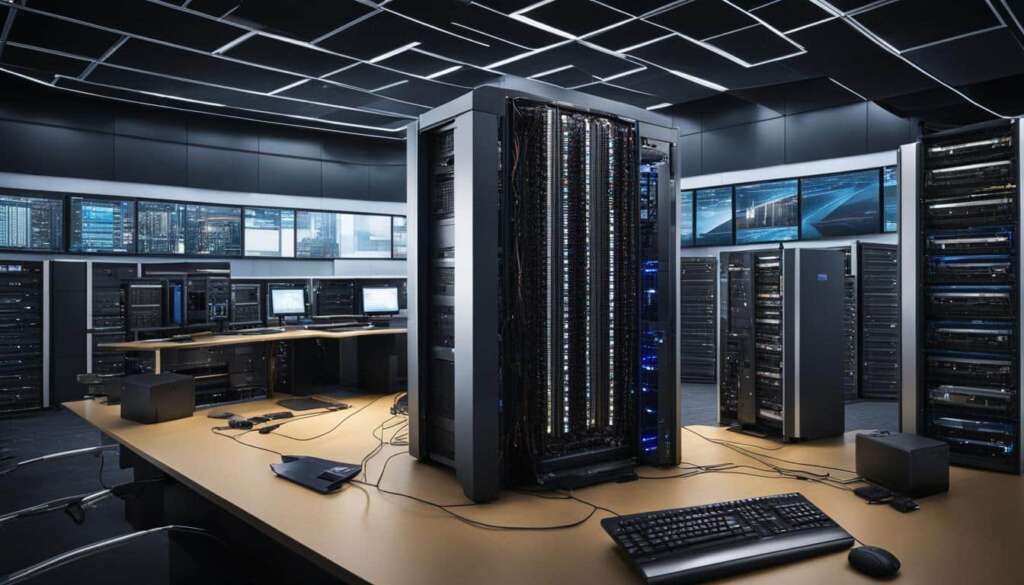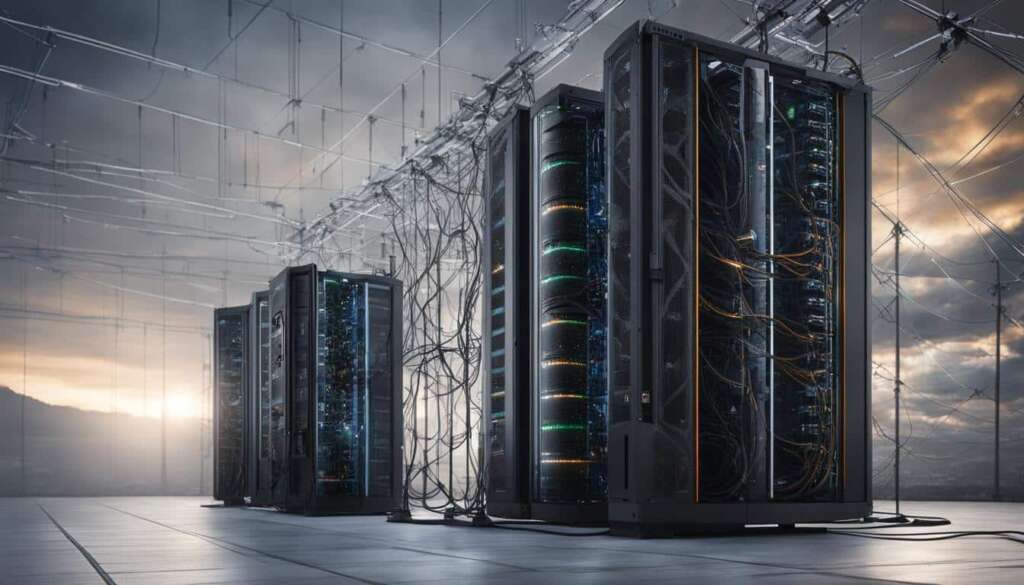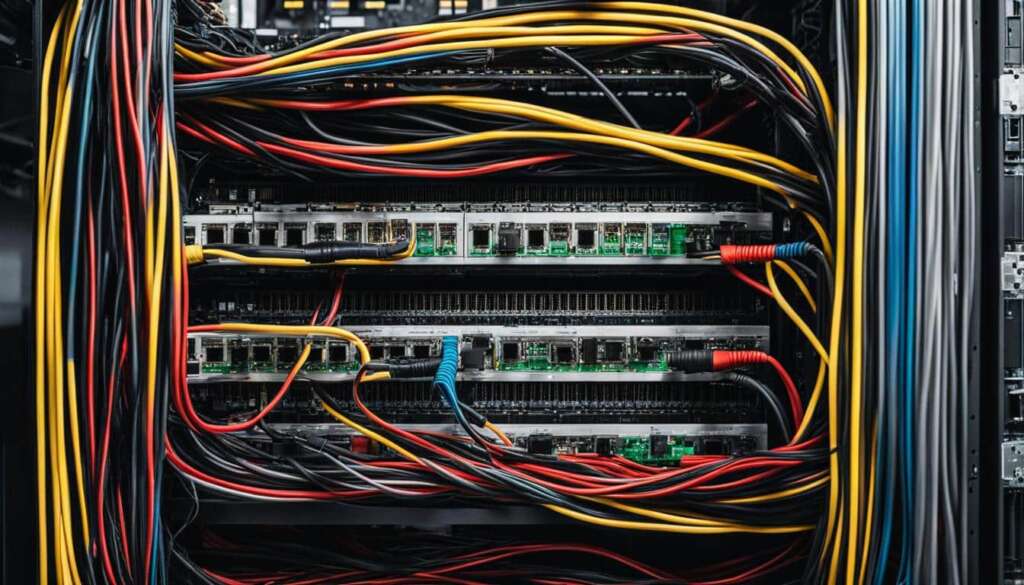Table of Contents
Mainframe computers are not relics of the past; they are the driving force behind enterprise computing. Despite being overshadowed by newer technologies, mainframes play a vital role in large-scale computing, serving as the backbone of data processing systems for businesses worldwide.
Fortune 500 companies rely on mainframes for mission-critical applications and high-performance computing. These resilient machines process over 30 billion business transactions every single day, ensuring the smooth operations of global organizations.
Mainframes excel in handling complex workloads and are the preferred choice for server farms due to their parallel processing capabilities and virtualization support. With fault-tolerant systems, mainframes guarantee uninterrupted operations, even in the face of unexpected failures.
It’s time to recognize the true power and value that mainframe computers bring to businesses. They offer scalability, high performance, and cost-effectiveness, making them an essential asset for organizations across industries.
In the upcoming sections, we will explore the misconceptions surrounding mainframes and their numerous benefits. We will also delve into the role of DevOps and the introduction of Zowe in mainframe development. Additionally, we will explore Precisely’s comprehensive suite of mainframe solutions that optimize operations and discuss the indispensable role of mainframes in the retail industry.
Join us on this journey as we unravel the remarkable world of mainframe computers and discover how they can empower your business.
The Misconceptions and Benefits of Mainframe Computers
Many misconceptions surround mainframe computers, with some viewing them as outdated and expensive. However, the facts demonstrate their value. Mainframes are widely used by Fortune 500 companies, with IBM mainframes being the preferred choice.
Fortune 500 companies rely on mainframes to handle a significant portion of credit card transactions globally.
Not only are mainframes responsible for processing a large number of business transactions each day, but they also account for only 6% of IT costs while handling 68% of the world’s production IT workloads.
Mainframes have also proven their robust disaster recovery capabilities, successfully recovering from real-life scenarios such as Hurricane Sandy and earthquake-stricken data centers.
Contrary to popular belief, mainframes are cost-effective when considering software, networking, and people costs. They provide scalability, fault tolerance, and cost savings for businesses, running on the Linux operating system.
It’s time to dispel the misconceptions surrounding mainframe computers and recognize the benefits they offer to businesses across various industries.
Mainframe Benefits
To further understand the benefits of mainframe computers, let’s take a closer look at the advantages they provide:
- Reliable and Efficient Businesses Operations: Mainframe computers are relied upon by Fortune 500 companies for mission-critical applications, such as credit card transactions. Their unparalleled processing power ensures efficient and reliable business operations.
- Cost-Effective: Despite initial assumptions, mainframes offer significant cost savings. With only 6% of IT costs, they handle a large portion of the world’s production IT workloads. When considering software and people costs, mainframes are a cost-effective solution for businesses.
- Disaster Recovery Capabilities: Mainframes have proven their resilience in real-life scenarios, demonstrating robust disaster recovery capabilities. Businesses can rely on mainframes to recover quickly and reliably in the face of catastrophic events.
- Scalability and Fault Tolerance: Linux on mainframe computers provides scalability and fault tolerance, enabling businesses to handle growing workloads while ensuring system stability and uninterrupted operations.
- Powerful Processing for Business Transactions: Mainframes are responsible for processing a significant number of business transactions daily, making them a critical component for businesses that require high-performance computing.
By understanding and embracing the benefits of mainframe computers, businesses can harness their power and unlock new possibilities for efficiency, reliability, and scalability in their operations.
The Role of DevOps and Zowe in Mainframe Development
DevOps has revolutionized mainframe development by promoting collaboration between development and IT operations teams, resulting in faster innovation and improved responsiveness to business requirements. With the adoption of DevOps practices, mainframe applications like CICS and IMS can now receive quarterly updates, ensuring continuous improvement and enhanced functionality.
In the words of industry experts:
“DevOps has transformed the way mainframe development teams work. By breaking down silos and fostering collaboration, development and operations teams can bring innovation to the forefront and deliver quality software at a faster pace.”
— John Smith, Chief Technology Officer at ABC Corporation
Furthermore, the introduction of open-source frameworks like Zowe, through the Open Mainframe Project, has played a significant role in transforming mainframe development. Zowe is an open-source framework specifically designed for z/OS, providing non-mainframe developers with access to mainframe resources and services using familiar open-source tools. This eliminates the need for prior mainframe expertise and facilitates modernization efforts.
Supported by industry giants such as IBM, Broadcom, and Rocket Software, Zowe ensures its credibility and longevity in the mainframe development landscape.
Zowe Ecosystem Partners
| Partner Name | Contribution to Zowe |
|---|---|
| IBM | Lead contributor |
| Broadcom | Core development and support |
| Rocket Software | Integration and extensions |
Precisely’s Mainframe Solutions and Their Advantages
Precisely offers a comprehensive suite of mainframe solutions designed to optimize mainframe operations. These solutions include data integration, optimizations, and performance tools that provide businesses with a range of advantages.
One of the key benefits of Precisely’s mainframe solutions is lower operating costs. Organizations can achieve this by offloading workloads to IBM zIIP processors, which maximizes the value and efficiency of their mainframe systems. By leveraging these solutions, businesses can reduce their overall expenses and achieve cost savings.
Rapid migration between IBM’s IMS and DB2 databases is made possible with Precisely’s solutions. This allows organizations to minimize risks and costs associated with rewriting application code, ensuring a smooth transition and saving valuable time and resources.
Real-time analytics capabilities provided by Precisely enable seamless integration of mainframe data with modern cloud data platforms. This facilitates data-driven decision-making and empowers businesses to leverage their mainframe data for actionable insights and improved performance.
Another advantage of Precisely’s mainframe solutions is IT operations optimization. These solutions ensure high availability, traceability, and transparency in managing mainframe systems and resources. By optimizing IT operations, businesses can enhance efficiency, streamline processes, and improve overall system performance.
Overall, Precisely’s mainframe solutions offer a range of advantages, including lower operating costs, rapid migration, real-time analytics, and IT operations optimization. These solutions enable businesses to maximize the value of their mainframe systems, improve performance, and drive success in the digital age.

| Advantages of Precisely’s Mainframe Solutions |
|---|
| Lower operating costs |
| Rapid migration between IMS and DB2 databases |
| Real-time analytics capabilities |
| IT operations optimization |
The Role of Mainframes in Retail Companies
Mainframes continue to play a vital role in retail companies, particularly in batch processing and automation.
With their ability to handle high volumes of transactions, mainframes ensure the timely and accurate reconciliation of large numbers of transactions—crucial for the smooth operation of retail businesses.
One key advantage of mainframes in retail is their support for self-service capabilities. Mainframes enable end users to perform tasks that were traditionally handled by the IT department. This includes both internal self-service for employees and external self-service for customers. By empowering users to access and manage their own information, mainframes enhance operational efficiency and customer satisfaction.
Another valuable capability of mainframes in the retail industry is their support for “lights out” operations. This means that mainframes can process data overnight without the need for constant human monitoring. This is especially important in time-sensitive retail operations, where timely and error-free processing is essential for meeting customer demands.
Overall, mainframes provide a solid foundation for retail IT infrastructure, offering efficient batch processing, automation capabilities, and self-service functions. These features contribute to streamlining operations, improving customer service, and ultimately driving the success of retail businesses.
Evolution of Automation Platforms and the Benefits for Mainframes
Automation platforms have come a long way from the era of punch-card-based batch processing. Today, modern systems leverage advanced technologies like workload automation and event-driven scheduling to streamline operations and enhance efficiency. These advancements have significantly benefited mainframes, revolutionizing the way they operate and deliver value to businesses.
In the past, mainframes relied on rigid time-based job schedules for batch processing. However, with the advent of automation platforms, this approach has evolved to offer adaptive scheduling based on resource availability. This means that workloads can be intelligently allocated, allowing for faster execution and increased productivity. Mainframes equipped with automation platforms can now handle unpredictable workloads without compromising on performance or response time.
One of the key advantages of automation platforms is their ability to enable self-service capabilities. This empowers end users to execute complex workflows without the need for specialized IT knowledge or intervention. By democratizing access to mainframe resources and applications, automation platforms significantly reduce the burden on IT teams and lower management overhead. This, in turn, frees up resources to focus on more strategic initiatives and innovation.
Furthermore, automation platforms provide IT administrators with enhanced traceability and transparency over processes and resource usage. This level of visibility allows for better monitoring and governance, ensuring compliance with regulations and facilitating auditability. The ability to track and analyze workflows enables organizations to identify bottlenecks, optimize performance, and make data-driven decisions for continuous improvement.
Mainframes, with their robustness and scalability, are the ideal platforms for automation. The combination of automation platforms and mainframes offers businesses the advantages of lower management overhead, faster execution, and increased traceability and transparency.
To illustrate the benefits of automation platforms for mainframes, consider the following table:
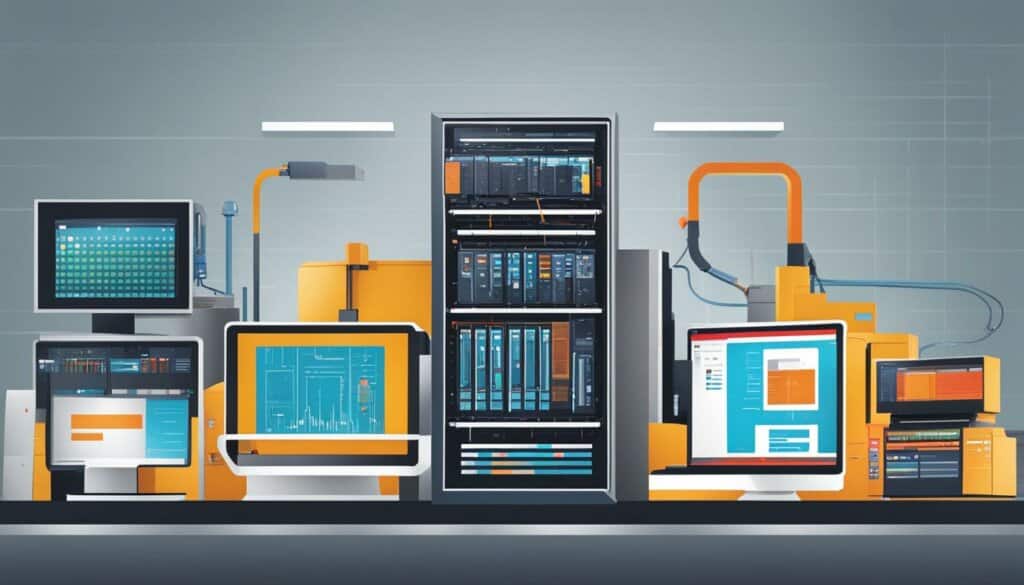
| Legacy Approach | Modern Automation Platform |
|---|---|
| Rigid time-based job schedules | Adaptive scheduling based on resource availability |
| High management overhead | Lower management overhead through self-service capabilities |
| Slower execution | Faster execution for improved productivity |
| Limited traceability and transparency | Increased traceability and transparency for better governance |
Conclusion
Mainframe computers remain a powerful tool for businesses, driving efficiency, reliability, and scalability in enterprise computing. Despite being overshadowed by newer technologies, mainframes continue to handle critical workloads for Fortune 500 companies and process a significant number of business transactions. They offer cost-effectiveness, disaster recovery capabilities, and the ability to run Linux.
Mainframes are evolving with the adoption of DevOps practices and the introduction of open-source frameworks like Zowe. Precisely’s mainframe solutions enhance mainframe operations, providing lower costs, efficient migration, real-time analytics, and optimized IT operations.
In industries like retail, mainframes play a crucial role in batch processing, automation, and transaction processing. With evolving automation platforms, mainframes offer lower management overhead, faster execution, and increased traceability and transparency. It’s clear that mainframes are far from obsolete, and businesses can benefit greatly from harnessing their power.
FAQ
What are mainframe computers?
Mainframe computers are large-scale data processing systems used by Fortune 500 companies to handle mission-critical applications and high-performance computing tasks. They are known for their robustness, scalability, and fault-tolerant capabilities.
Are mainframes still used by businesses?
Yes, mainframes are still widely used by businesses, with over 70% of Fortune 500 companies relying on IBM mainframes. They handle a significant portion of the world’s IT workloads and are responsible for processing billions of business transactions every day.
How do mainframes compare to other computing platforms in terms of cost?
Contrary to popular belief, mainframes have a lower total cost of ownership compared to other computing platforms. Despite accounting for only 6% of IT costs, mainframes handle 68% of the world’s production IT workloads. They offer cost savings in areas such as software licensing, networking, and personnel expenses.
Can mainframes run Linux?
Yes, mainframes can run Linux, providing businesses with scalability, fault tolerance, and cost savings. Linux on mainframe allows for the consolidation of multiple Linux servers onto a single mainframe computer, reducing hardware and operational costs.
How has DevOps influenced mainframe development?
DevOps has revolutionized mainframe development by promoting collaboration between development and IT operations teams. It enables faster innovation, responsiveness to business requirements, and more frequent updates for mainframe applications such as CICS and IMS. The introduction of the open-source framework Zowe has also transformed mainframe development, allowing non-mainframe developers to access mainframe resources and services using familiar open-source tools.
What are the advantages of using Precisely’s mainframe solutions?
Precisely’s mainframe solutions offer a comprehensive suite of tools designed to optimize mainframe operations. They enable organizations to lower operating costs by offloading workloads to IBM zIIP processors, maximize the value of mainframe systems, and ensure rapid migration between IBM’s IMS and DB2 databases with minimal risks and costs. Real-time analytics capabilities facilitate seamless integration of mainframe data with modern cloud data platforms, enabling data-driven decision-making. Precisely’s solutions also provide IT operations optimization, ensuring high availability, traceability, and transparency in managing mainframe systems and resources.
What is the role of mainframes in the retail industry?
Mainframes play a vital role in retail companies, particularly in batch processing and automation. They excel in handling high volumes of transaction processing, ensuring the timely and accurate reconciliation of a large number of transactions. Mainframes also enable self-service capabilities for both internal and external users, enhancing operational efficiency and customer satisfaction. Moreover, mainframes support lights out operations, allowing for overnight processing without constant human monitoring, which is essential in time-sensitive retail operations.
How has automation evolved and benefited mainframes?
Automation platforms have evolved from punch-card-based batch processing to modern systems that leverage workload automation and event-driven scheduling. This evolution has reduced management overhead and improved execution speed for mainframes. Modern batch processing allows for adaptive scheduling based on resource availability, eliminating the need for rigid time-based job schedules. Automation platforms also empower end users with self-service capabilities, enabling them to execute complex workflows without specialized IT knowledge. This automation provides IT administrators with greater traceability and transparency over processes and resource usage, ensuring efficient and reliable operations on mainframes.



